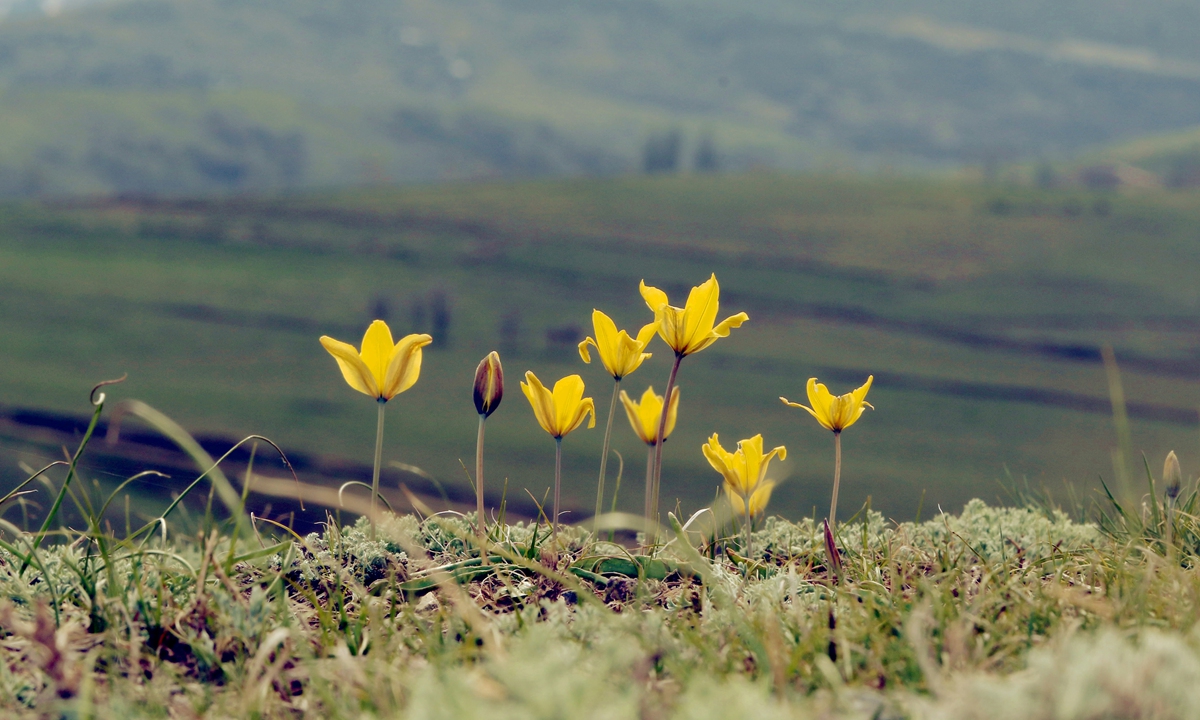ARTS / PHOTOGRAPHY
Plant expert in Xinjiang region raises green awareness through livestreaming

Xinjiang tulips Photo: Courtesy of Yang Zongzong
In late July, Yang Zongzong drove himself up into the vast mountain ranges bordering Mongolia and Russia in Northwest China's Xinjiang Uygur Autonomous Region to search for an extremely rare plant that had been mentioned in many classic Chinese novels.
"We finally found it in the end, yet experienced twists and turns we couldn't have ever imagined. When we found the xuelian flower [snow lotus] blooming out of a stone seam, it was so charming. It was in fact glowing under the sun, just like the novelists described in their stories," he said.
From glaciers to riversides in no man's land, Yang, born in Urumqi in the 1980s, has been driving to all parts of Xinjiang to film and document plants on the edge of extinction and raise people's awareness.
During his eight years of searching, he discovered new plants that the botanical world had never recorded before, documented more than 2,000 rare blooming flowers and advocated a message of plant conservation through his live streams broadcast from the deep wilderness.
"Though we would fully prepare before departure, I still got separated once from my companions and was lost in the wild without a phone signal. Despite this, my passion for tracking down plants and going on adventures will never change," Yang told the Global Times.
Poison not cure
The snow lotus Yang and his tour guide friend Lei Yiming discovered in July was found at the foot of a glacier inside a national natural reserve some 4,600 meters above sea level in the Altay Mountains.
The verticality of the Altay Mountains in Xinjiang has created a unique and mysterious natural landscape that is home to some of the rarest plants in the world.

Yang Zongzong takes photos of a flower. Photo: Courtesy of Yang Zongzong
In China's most popular wuxia (martial arts) novels, the snow lotus is an extremely precious and magical medicinal herb. The plant is used as a cure for everything and even "people who are at the edge of dying can be returned to life."
Usually used by locals as an ingredient in cooking for years, overrated rumors of its value and the fact it only blooms once every five years makes the snow lotus one of the most popular plants for poachers to dig up and sell.
"Decades ago, whenever people got a hold of this rare flower, they would soak it in chicken soup as a complementary ingredient that they thought was good for their health. But it is in fact poisonous and definitely not the best choice for an ingredient," Yang said.
The plant was listed as national second-class protected plant in China in 1996.
Over the past few years, with the country's emphasis on ecological protection, the local government in Xinjiang has cracked down on the illegal removal of the snow lotus.
The efforts from both the government and locals have reduced plant poaching and allowed the wild species to recover.
However, in Yang's opinion a lack of awareness of protection and "how important this species is in the ecosystems of the mountainous region means the situation has yet to be fully reversed."
"Science is key to advancing a society, but for me popularizing knowledge is equally important."
Raising awareness
As a young man, Yang was a frequent guest in libraries when he lived in Beijing, where he would buy all the thick botanical illustration books that many people easily pass by without noticing.
When he returned to Xinjiang, Young set up his own studio to work with plants.
He calls himself a "plant hunter," a term referring to a time when European military officers, missionaries and naturalists traveled around the world searching for exotic plants to bring home.
In his view the responsibility of a modern plant hunter is to temper the spirit of exploration and adventure with the realities of environmental protection.
In April 2022, the UN Biodiversity Conference took place in Kunming, Southwest China's Yunnan Province. Not willing to let this opportunity pass him by, Yang held many exhibitions to introduce the unique plants in China to visitors. One of his major focuses was a plant currently on the brink of extinction - Xinjiang tulips.
This native species, found in Xinjiang at altitudes of more than 2,000 meters above sea level, blooms in late April to mid-May.
"Yet many locals don't think clearly about their protection. When we first went out on the streets and told them not to dig up tulips some showed resistance," recalled Yang.
Yang and his friends chose to cooperate with a local NGO in Xinjiang to give speeches and presentations to raise locals' awareness toward this indispensable natural resource.
Through their years of efforts, all wild tulip species in Xinjiang were listed as second-level national protected plants in 2021.
He noted that the efforts of local governments over the past few decades have been a major source of motivation for him to continue his work.
Over the past few years of studying plants in the field, he has discovered a variety of plants that have not yet been recorded and has been working with scholars from all over the world to name these new species.
Yang likens the discovery of a new species to the discovery of an asteroid.
"Naming a new species is the highest honor for us plant researchers," he said proudly.

